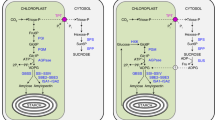Abstract.
Tobacco (Nicotiana tabacum L.) plants were transformed with an antisense construct of the chloroplast triose phosphate/phosphate translocator (TPT). Three transformant lines of the T4 progeny, which showed a large decrease in the transcript level of the TPT were used for further biochemical and physiological characterisation. In all antisense lines tested, TPT transport activity was diminished by 50–70% compared with the wild type (WT). Despite this high reduction in the transport capacity, αTPT plants lacked any visible phenotype. Hexokinase and α-amylase activities were increased in αTPT plants compared with the WT, whereas activities of ribulose-1,5-bisphosphate carboxylase/oxygenase and ADP-glucose pyrophosphorylase (AGPase) were not affected. At the end of a 14-h light period, leaf starch contents in αTPT lines were similar to those of the WT and controls, indicating that a decrease in the TPT had no effect on starch accumulation. Sucrose contents were diminished by more than 50% in αTPT lines compared with control plants. The time course of starch accumulation revealed a transient increase in the starch content in a selected αTPT line after 6 h in the light, followed by a decrease towards the end of the light period. Labelling with 14C indicated that during the dark and light (late afternoon) periods starch is mobilised at higher rates in αTPT lines than in the controls. Glucose/fructose ratios at the end of the dark period were increased from 1.2 in control plants to 2 in αTPT lines indicating increased amylolytic starch degradation. Initial rates of [14C] glucose transport in isolated chloroplasts were increased by a factor of 2–3 in αTPT plants compared with the WT. Rates of CO2 assimilation were substantially diminished in the αTPT lines in high CO2 and low O2, but remained unaffected in ambient CO2. The rate of photosynthetic electron transport during the induction of photosynthesis in saturating CO2 exhibited pronounced oscillations only in WT and control plants. Oscillations were less pronounced in αTPT plants, indicating that phosphate limitation of photosynthesis is lowered in αTPT plants compared with the WT. It is proposed that photoassimilates are more readily directed into starch biosynthesis in αTPT plants. This is supported by determinations of 3-phosphoglycerate levels (an activator of AGPase) during the transition from dark to light in high CO2.
Similar content being viewed by others
Author information
Authors and Affiliations
Additional information
Received: 23 May 1997 / Accepted: 24 July 1997
Rights and permissions
About this article
Cite this article
Häusler, R., Schlieben, N., Schulz, B. et al. Compensation of decreased triose phosphate/phosphate translocator activity by accelerated starch turnover and glucose transport in transgenic tobacco. Planta 204, 366–376 (1998). https://doi.org/10.1007/s004250050268
Issue Date:
DOI: https://doi.org/10.1007/s004250050268




